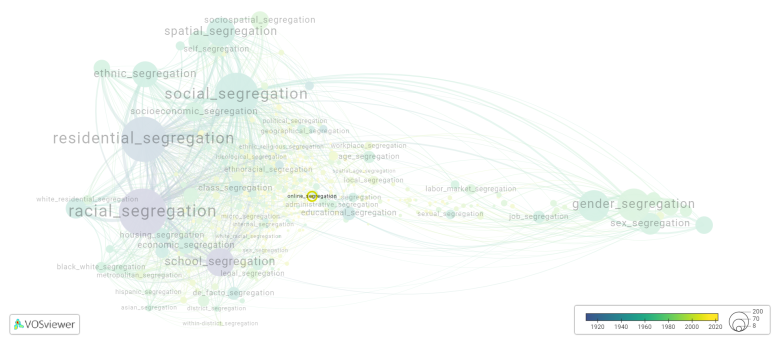Online segregation: Difference between revisions
(Creating page) |
(Creating page) |
||
| (4 intermediate revisions by the same user not shown) | |||
| Line 11: | Line 11: | ||
It is important to promote inclusivity and diversity in online spaces in order to foster meaningful dialogue and understanding among people from different backgrounds. This can be achieved by encouraging collaboration and interaction across various online platforms, promoting digital literacy and critical thinking skills, and implementing policies that discourage online segregation and support a more inclusive internet experience for all users. | It is important to promote inclusivity and diversity in online spaces in order to foster meaningful dialogue and understanding among people from different backgrounds. This can be achieved by encouraging collaboration and interaction across various online platforms, promoting digital literacy and critical thinking skills, and implementing policies that discourage online segregation and support a more inclusive internet experience for all users. | ||
==== | ==See also== | ||
==Related segregation forms== | |||
Online segregation is frequently discussed in the literature with the following segregation forms: | |||
[[online ethnic segregation]] | |||
[[File:online_segregation.png|780x780px]] | |||
This visualization is based on the study [[Segregation_Wiki:About| The Multidisciplinary Landscape of Segregation Research]]. | |||
For the complete network of interrelated segregation forms, please refer to: | |||
* [https://tinyurl.com/2235lkhw First year of publication] | |||
* [https://tinyurl.com/2d8wg5n3 Louvain clusters] | |||
* [https://tinyurl.com/223udk5r Betweenness centrality] | |||
* [https://tinyurl.com/244d8unz Disciplines in which segregation forms first emerged (Scopus database).] | |||
==References== | ==References== | ||
==Notes== | ==Notes== | ||
<references /> | <references /> | ||
{{NoteAI}} | {{NoteAI}} | ||
==Online | ==Online segregation appears in the following literature== | ||
Duvanova D., Nikolaev A., Nikolsko-Rzhevskyy A., Semenov A. (2016 | Duvanova D., Nikolaev A., Nikolsko-Rzhevskyy A., Semenov A. (2016). Violent conflict and online segregation: An analysis of social network communication across Ukraine's regions. ''Journal of Comparative Economics'', ''44''(1), 163-181. Academic Press Inc..https://doi.org/10.1016/j.jce.2015.10.003 | ||
Nisser A., Weidmann N.B. (2018 | Nisser A., Weidmann N.B. (2018). Online ethnic segregation in a post conflict setting. ''European Journal of Communication'', ''33''(5), 489-504. SAGE Publications Ltd.https://doi.org/10.1177/0267323118784816 | ||
Latest revision as of 07:17, 16 October 2024
Date and country of first publication[1][edit | edit source]
2016
United States
Definition[edit | edit source]
Online segregation refers to the practice of dividing internet users into separate communities or platforms based on their race, gender, or other characteristics. This can occur through various means, such as online forums or social media platforms that cater exclusively to certain groups.
While the internet has the potential to connect people from diverse backgrounds and foster cross-cultural understanding, online segregation can hinder this process by creating echo chambers and reinforcing existing social divisions. It can lead to the formation of isolated online communities that only interact with people who share similar beliefs, resulting in limited exposure to different perspectives and ideas.
Online segregation can also contribute to the spread of misinformation and hate speech, as individuals within segregated communities may reinforce and amplify extreme views without being exposed to counterarguments or alternative viewpoints. This can further polarize online discussions and exacerbate societal divisions.
It is important to promote inclusivity and diversity in online spaces in order to foster meaningful dialogue and understanding among people from different backgrounds. This can be achieved by encouraging collaboration and interaction across various online platforms, promoting digital literacy and critical thinking skills, and implementing policies that discourage online segregation and support a more inclusive internet experience for all users.
See also[edit | edit source]
Related segregation forms[edit | edit source]
Online segregation is frequently discussed in the literature with the following segregation forms:
This visualization is based on the study The Multidisciplinary Landscape of Segregation Research.
For the complete network of interrelated segregation forms, please refer to:
References[edit | edit source]
Notes[edit | edit source]
- ↑ Date and country of first publication as informed by the Scopus database (December 2023).
At its current state, this definition has been generated by a Large Language Model (LLM) so far without review by an independent researcher or a member of the curating team of segregation experts that keep the Segregation Wiki online. While we strive for accuracy, we cannot guarantee its reliability, completeness and timeliness. Please use this content with caution and verify information as needed. Also, feel free to improve on the definition as you see fit, including the use of references and other informational resources. We value your input in enhancing the quality and accuracy of the definitions of segregation forms collectively offered in the Segregation Wiki ©.
Online segregation appears in the following literature[edit | edit source]
Duvanova D., Nikolaev A., Nikolsko-Rzhevskyy A., Semenov A. (2016). Violent conflict and online segregation: An analysis of social network communication across Ukraine's regions. Journal of Comparative Economics, 44(1), 163-181. Academic Press Inc..https://doi.org/10.1016/j.jce.2015.10.003
Nisser A., Weidmann N.B. (2018). Online ethnic segregation in a post conflict setting. European Journal of Communication, 33(5), 489-504. SAGE Publications Ltd.https://doi.org/10.1177/0267323118784816

